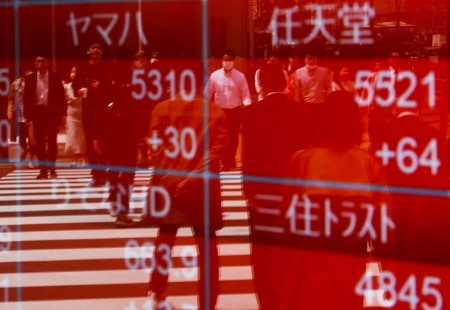




Policy Rate Updates: Double cut finale
 DOWNLOAD
DOWNLOAD

Monthly Economic Update: One for the road
 DOWNLOAD
DOWNLOAD

Inflation Update: Still low, still slow
 DOWNLOAD
DOWNLOAD


Stocks set for range trading as central banks near end game

BENGALURU, May 25 (Reuters) – Global stock indices will end this year higher than where they started it but most are set to be confined to ranges in coming months even as central banks approach the endgame for interest rate rises, according to Reuters polls of market strategists.
Despite the drubbing in 2022 and starting the year on the back foot, global stocks have recovered from March lows based on expectations that most central banks were done or nearly done with in some cases more than a year of raising interest rates.
The MSCI global stock index, which fell more than 8.5% between Feb. 2 and March 15 following the failure of a few US regional banks, has since recouped nearly all of those losses and is up about 9% for the year.
Still, there is barely any improvement to the outlook for major indices at year-end compared to a survey taken three months ago before the turmoil. Year-end forecasts for 10 of the 17 indices polled May 10-24 have been downgraded.
This suggests stocks are no longer a one-way bet in the minds of investors like they were for swathes of the last decade, in large part because there is little scope for central banks swooping in to cut borrowing costs any time soon.
“Although monetary tightening has been a drag on equities over the past year or so, we don’t think the end of rate hikes means the stock market is set for big gains,” said Thomas Mathews, senior market economist at Capital Economics.
Mathews added that “any hopes of a boost to equities from an end to monetary tightening will probably be dashed.”
Among analysts with a view on what the dominant trend for stock indexes will be over the coming months, a two-thirds majority, 64 of 97, predict narrow-range trading. Nineteen said they would rally and the remaining 14 predicted a correction.
Manish Kabra, head of US equity strategy at Societe Generale, noted the “fear of missing out” factor that has driven stocks in the recent past was no longer convincing, as there were multiple reasons to not load up on stocks and “we should see credit risks and bond volatility pick up again.”
While there was no majority among 104 analysts who had a view on the primary drive for stock markets over the coming three months, two related responses, economic data (39) and monetary policy (27) were the top picks.
Those were followed by company earnings (19) and other reasons (19).
With central banks’ actions expected to have an outsized say over stock price movements, the European indices and the Nikkei which outperformed their developed and emerging peers were expected to shed the most by year-end.
The STOXX index of the euro zone’s top 50 blue chips was forecast to fall about 2% from Monday’s close to 4,300 points by the end of December. The index is up 15.6% year to date.
Britain’s FTSE 100 was predicted to end the year at 7,775 points, broadly in line with Monday’s close.
Japan’s Nikkei 225 was predicted to drop 4% from 33-year highs, returning to the psychologically key 30,000 level by year-end.
The benchmark US S&P 500 index which lost over 19% last year, its worst annual performance since 2008, is up around 8% this year and was forecast to trade around current levels to close 2023 at 4,150.
Brazil’s Bovespa and Mexico’s S&P/BMV IPC stock index were forecast to gain nearly 9.0% and 7.5% respectively by end-2023. Both countries’ central banks were widely expected to cut rates over the next 12 months.
(Reporting by Hari Kishan and Sarupya Ganguly; Additional reporting and polling by correspondents in Bengaluru, Buenos Aires, London, Mexico City, Milan, New York, San Francisco, Sao Paulo, Tokyo, and Toronto; Editing by Ross Finley, William Maclean)
This article originally appeared on reuters.com





 By Reuters
By Reuters